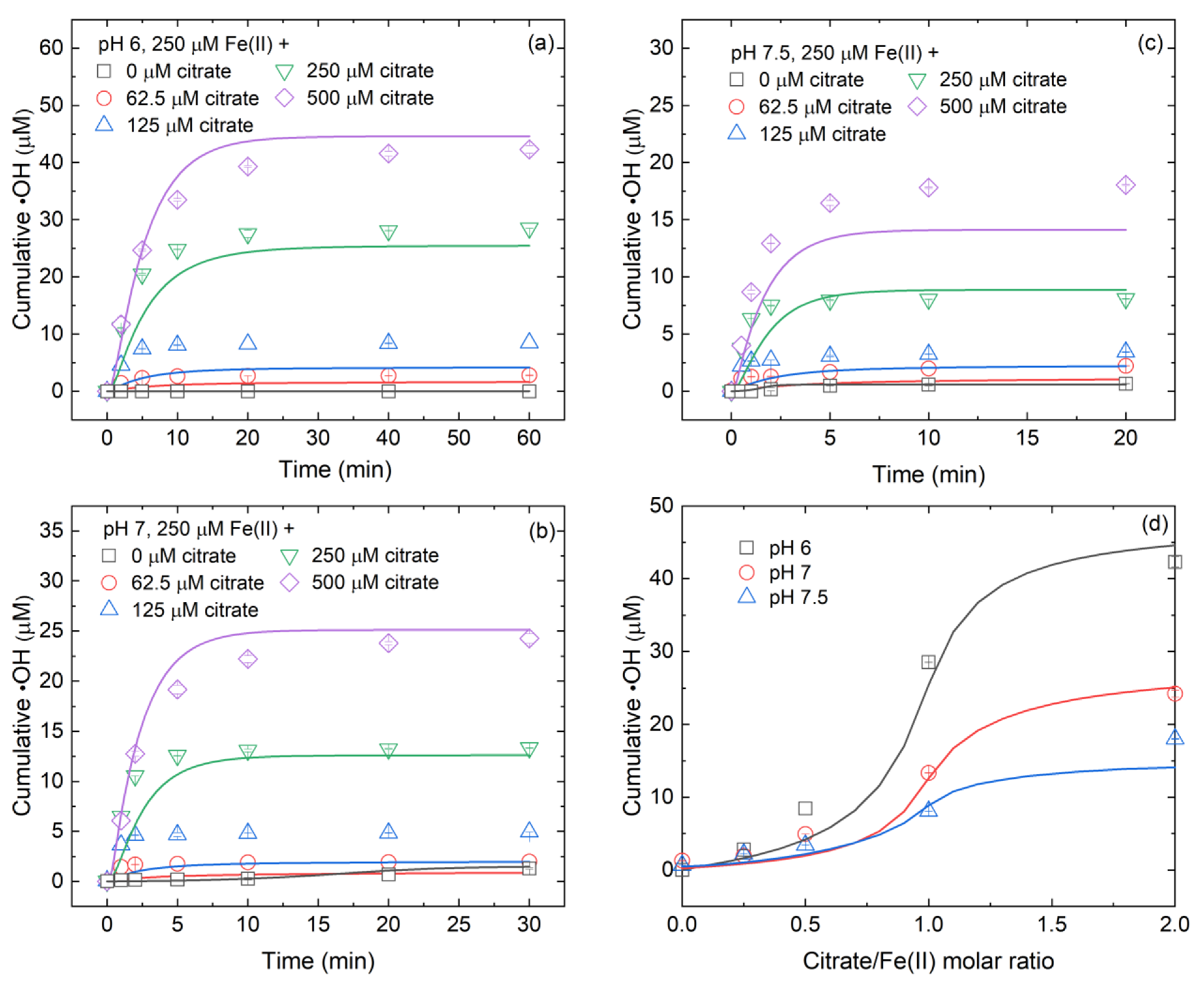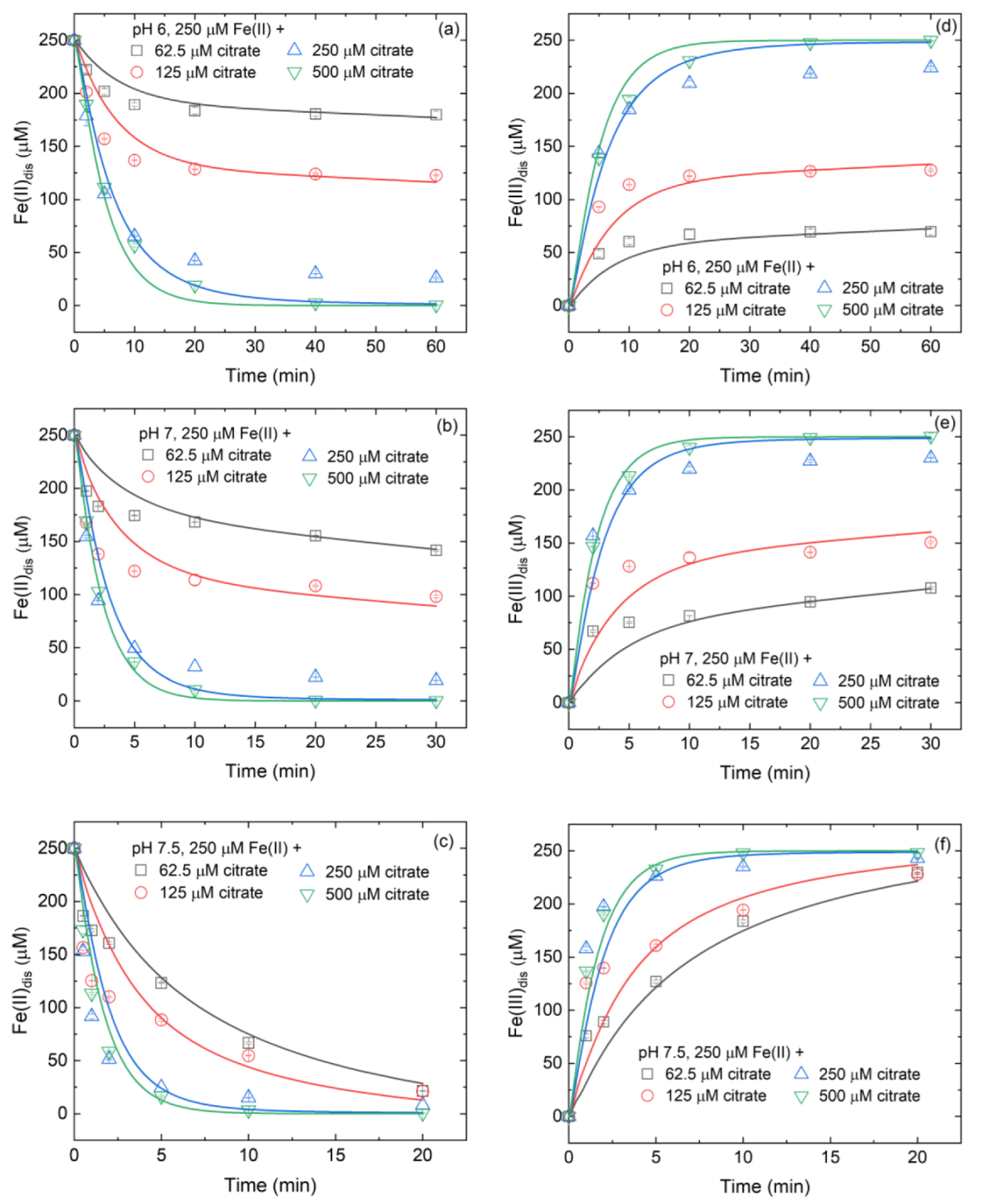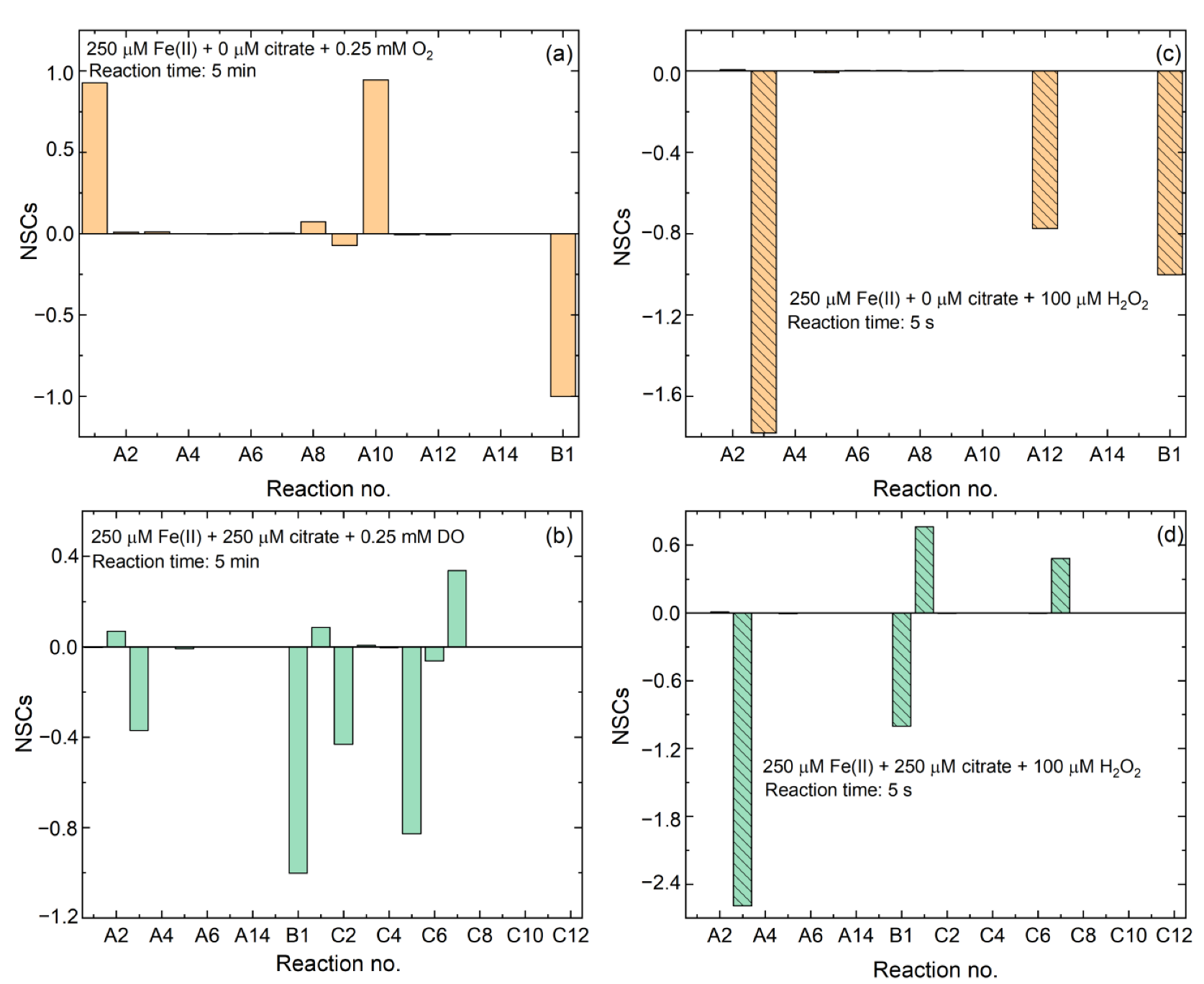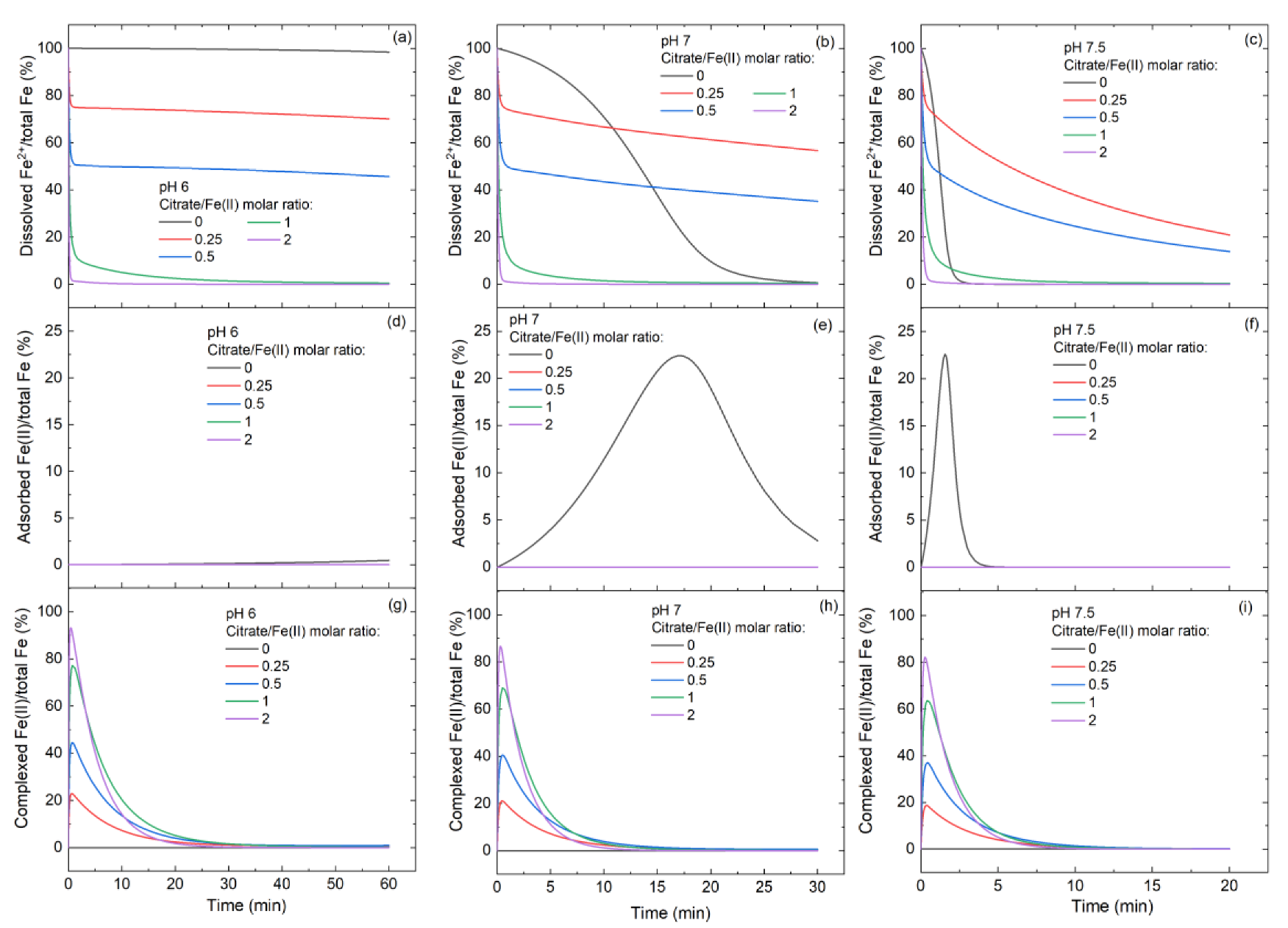Quantification of the Influence of Citrate/Fe(II) Molar Ratio on Hydroxyl Radical Production and Pollutant Degradation during Fe(II)-Catalyzed O2 and H2O2 Oxidation Processes
Abstract
:1. Introduction
2. Materials and Methods
2.1. Chemicals
2.2. Oxic Experiments
2.3. Anoxic Experiments
2.4. Analysis
2.5. Kinetic Modeling and Speciation Calculation
3. Results and Discussion
3.1. Effect of Citrate/Fe(II) Molar Ratio on •OH Production during Fe(II)-Catalyzed O2 Oxidation Process
3.2. Effect of Citrate/Fe(II) Molar Ratio on •OH Yield during Fe(II)-Catalyzed H2O2 Oxidation Process
3.3. Variation of Fe(II)/Fe(III) Species at Different Citrate/Fe(II) Ratios during Oxidation Process
3.4. Controlling Mechanisms of Citrate/Fe(II) Molar Ratio on •OH Production
3.5. Effect of Citrate/Fe(II) Molar Ratio on Phenol Degradation during Fe(II)-Catalyzed O2 Oxidation Process
4. Conclusions
Supplementary Materials
Author Contributions
Funding
Institutional Review Board Statement
Informed Consent Statement
Data Availability Statement
Conflicts of Interest
References
- Huang, J.; Jones, A.; Waite, T.D.; Chen, Y.; Huang, X.; Rosso, K.M.; Kappler, A.; Mansor, M.; Tratnyek, P.G.; Zhang, H. Fe(II) redox chemistry in the environment. Chem. Rev. 2021, 121, 8161–8233. [Google Scholar] [CrossRef]
- Zhou, Q.; Ma, S.; Zhan, S. Superior photocatalytic disinfection effect of Ag-3D ordered mesoporous CeO2 under visible light. Appl. Catal. B Environ. 2018, 224, 27–37. [Google Scholar] [CrossRef]
- Tsydenova, O.; Batoev, V.; Batoeva, A. Solar-enhanced advanced oxidation processes for water treatment: Simultaneous removal of pathogens and chemical pollutants. Int. J. Environ. Res. Public Health 2015, 12, 9542–9561. [Google Scholar] [CrossRef] [PubMed] [Green Version]
- Aseev, D.; Batoeva, A.; Sizykh, M.; Olennikov, D.; Matafonova, G. Degradation of bisphenol A in an aqueous solution by a photo-Fenton-like process using a UV KrCl excilamp. Int. J. Environ. Res. Public Health 2021, 18, 1152. [Google Scholar] [CrossRef] [PubMed]
- Liu, X.; Yuan, S.; Tong, M.; Liu, D. Oxidation of trichloroethylene by the hydroxyl radicals produced from oxygenation of reduced nontronite. Water Res. 2017, 113, 72–79. [Google Scholar] [CrossRef] [PubMed] [Green Version]
- Schaefer, C.E.; Ho, P.; Berns, E.; Werth, C. Mechanisms for abiotic dechlorination of trichloroethene by ferrous minerals under oxic and anoxic conditions in natural sediments. Environ. Sci. Technol. 2018, 52, 13747–13755. [Google Scholar] [CrossRef]
- Tong, M.; Yuan, S.; Ma, S.; Jin, M.; Liu, D.; Cheng, D.; Liu, X.; Gan, Y.; Wang, Y. Production of abundant hydroxyl radicals from oxygenation of subsurface sediments. Environ. Sci. Technol. 2016, 50, 214–221. [Google Scholar] [CrossRef]
- Chen, N.; Huang, D.; Liu, G.; Chu, L.; Fang, G.; Zhu, C.; Zhou, D.; Gao, J. Active iron species driven hydroxyl radicals formation in oxygenation of different paddy soils: Implications to polycyclic aromatic hydrocarbons degradation. Water Res. 2021, 203, 117484. [Google Scholar] [CrossRef] [PubMed]
- Xie, W.; Yuan, S.; Tong, M.; Ma, S.; Liao, W.; Zhang, N.; Chen, C. Contaminant degradation by •OH during sediment oxygenation: Dependence on Fe(II) species. Environ. Sci. Technol. 2020, 54, 2975–2984. [Google Scholar] [CrossRef]
- Cheng, D.; Neumann, A.; Yuan, S.H.; Liao, W.J.; Qian, A. Oxidative degradation of organic contaminants by FeS in the presence of O2. Environ. Sci. Technol. 2020, 54, 4091–4101. [Google Scholar] [CrossRef] [PubMed]
- Zhang, Y.; Zhou, M. A critical review of the application of chelating agents to enable Fenton and Fenton-like reactions at high pH values. J. Hazard. Mater. 2019, 362, 436–450. [Google Scholar] [CrossRef] [PubMed]
- Remucal, C.K.; Sedlak, D.L. The role of iron coordination in the production of reactive oxidants from ferrous iron oxidation by oxygen and hydrogen peroxide. In Aquatic Redox Chemistry; ACS Publications: Washington, DC, USA, 2011; pp. 177–197. [Google Scholar]
- Cheng, D.; Yuan, S.; Liao, P.; Zhang, P. Oxidizing impact induced by mackinawite (FeS) nanoparticles at oxic conditions due to production of hydroxyl radicals. Environ. Sci. Technol. 2016, 50, 11646–11653. [Google Scholar] [CrossRef] [PubMed]
- Zhu, J.; Zhang, P.; Yuan, S.; Liao, P.; Qian, A.; Liu, X.; Tong, M.; Li, L. Production of Hydroxyl radicals from oxygenation of simulated AMD due to CaCO3-induced pH increase. Water Res. 2017, 111, 118–126. [Google Scholar] [CrossRef]
- Liu, X.X.; Yuan, S.H.; Zhang, P.; Zhu, J.; Tong, M. Reduced nontronite-activated H2O2 for contaminants degradation: The beneficial role of clayed fractions in ISCO treatments. J. Hazard. Mater. 2020, 386, 121945. [Google Scholar] [CrossRef]
- Xie, W.; Zhang, P.; Liao, W.; Tong, M.; Yuan, S. Ligand-enhanced electron utilization for trichloroethylene degradation by •OH during sediment oxygenation. Environ. Sci. Technol. 2021, 55, 7044–7051. [Google Scholar] [CrossRef]
- Keenan, C.R.; Sedlak, D.L. Ligand-enhanced reactive oxidant generation by nanoparticulate zero-valent iron and oxygen. Environ. Sci. Technol. 2008, 42, 6936–6941. [Google Scholar] [CrossRef] [PubMed] [Green Version]
- Zhang, P.; Yuan, S. Production of hydroxyl radicals from abiotic oxidation of pyrite by oxygen under circumneutral conditions in the presence of low-molecular-weight organic acids. Geochim. Cosmochim. Acta 2017, 218, 153–166. [Google Scholar] [CrossRef]
- Zeng, Q.; Dong, H.; Wang, X. Effect of ligands on the production of oxidants from oxygenation of reduced Fe-bearing clay mineral nontronite. Geochim. Cosmochim. Acta 2019, 251, 136–156. [Google Scholar] [CrossRef]
- Lewis, S.; Lynch, A.; Bachas, L.; Hampson, S.; Ormsbee, L.; Bhattacharyya, D. Chelate-modified Fenton reaction for the degradation of trichloroethylene in aqueous and two-phase systems. Environ. Eng. Sci. 2009, 26, 849–859. [Google Scholar] [CrossRef] [PubMed]
- Miller, C.J.; Rose, A.L.; Waite, T.D. Importance of iron complexation for Fenton-mediated hydroxyl radical production at circumneutral pH. Front. Mar. Sci. 2016, 3, 134. [Google Scholar] [CrossRef]
- Miller, C.J.; Rose, A.L.; Waite, T.D. Hydroxyl radical production by H2O2-mediated oxidation of Fe(II) complexed by Suwannee River fulvic acid under circumneutral freshwater conditions. Environ. Sci. Technol. 2013, 47, 829–835. [Google Scholar] [CrossRef] [PubMed]
- Lee, J.; Kim, J.; Choi, W. Oxidation of aquatic pollutants by ferrous-oxalate complexes under dark aerobic conditions. J. Hazard. Mater. 2014, 274, 79–86. [Google Scholar] [CrossRef] [PubMed]
- Jones, A.M.; Griffin, P.J.; Waite, T.D. Ferrous iron oxidation by molecular oxygen under acidic conditions: The effect of citrate, EDTA and fulvic acid. Geochim. Cosmochim. Acta 2015, 160, 117–131. [Google Scholar] [CrossRef]
- Mopper, K.; Zhou, X.L. Hydroxyl radical photoproduction in the sea and its potential impact on marine processes. Science 1990, 250, 661–664. [Google Scholar] [CrossRef]
- Joo, S.H.; Feitz, A.J.; Sedlak, D.L.; Waite, T.D. Quantification of the oxidizing capacity of nanoparticulate zero-valent iron. Environ. Sci. Technol. 2005, 39, 1263–1268. [Google Scholar] [CrossRef]
- Buxton, G.V.; Greenstock, C.L.; Helman, W.P.; Ross, A.B. Critical-review of rate constants for reactions of hydrated electrons, hydrogen-atoms and hydroxyl radicals (•OH/•O−) in aqueous-solution. J. Phys. Chem. Ref. Data 1988, 17, 513–886. [Google Scholar] [CrossRef] [Green Version]
- Zhang, P.; Yuan, S.; Liao, P. Mechanisms of hydroxyl radical production from abiotic oxidation of pyrite under acidic conditions. Geochim. Cosmochim. Acta 2016, 172, 444–457. [Google Scholar] [CrossRef]
- Viollier, E.; Inglett, P.; Hunter, K.; Roychoudhury, A.; Van Cappellen, P. The ferrozine method revisited: Fe(II)/Fe(III) determination in natural waters. Appl. Geochem. 2000, 15, 785–790. [Google Scholar] [CrossRef]
- Ianni, J.C. Kintecus. Windows Version 6.51. 2018. Available online: www.kintecus.com (accessed on 10 July 2022).
- Rose, A.L.; Waite, T.D. Kinetic model for Fe(II) oxidation in seawater in the absence and presence of natural organic matter. Environ. Sci. Technol. 2002, 36, 433–444. [Google Scholar] [CrossRef]
- Pham, A.N.; Waite, T.D. Oxygenation of Fe(II) in natural waters revisited: Kinetic modeling approaches, rate constant estimation and the importance of various reaction pathways. Geochim. Cosmochim. Acta 2008, 72, 3616–3630. [Google Scholar] [CrossRef]
- Pham, A.N.; Rose, A.L.; Feitz, A.J.; Waite, T.D. Kinetics of Fe(III) precipitation in aqueous solutions at pH 6.0–9.5 and 25 °C. Geochim. Cosmochim. Acta 2006, 70, 640–650. [Google Scholar] [CrossRef]
- Kinsela, A.S.; Jones, A.M.; Bligh, M.W.; Pham, A.N.; Collins, R.N.; Harrison, J.J.; Wilsher, K.L.; Payne, T.E.; Waite, T.D. Influence of dissolved silicate on rates of Fe(II) oxidation. Environ. Sci. Technol. 2016, 50, 11663–11671. [Google Scholar] [CrossRef] [PubMed] [Green Version]
- Lin, S.-S.; Gurol, M.D. Catalytic decomposition of hydrogen peroxide on iron oxide: Kinetics, mechanism, and implications. Environ. Sci. Technol. 1998, 32, 1417–1423. [Google Scholar] [CrossRef]
- Rose, A.L.; Waite, T.D. Reduction of organically complexed ferric iron by superoxide in a simulated natural water. Environ. Sci. Technol. 2005, 39, 2645–2650. [Google Scholar] [CrossRef]
- Fujii, M.; Rose, A.L.; Omura, T.; Waite, T.D. Effect of Fe(II) and Fe(III) transformation kinetics on iron acquisition by a toxic strain of Microcystis aeruginosa. Environ. Sci. Technol. 2010, 44, 1980–1986. [Google Scholar] [CrossRef]
- Garg, S.; Rose, A.L.; Waite, T.D. Superoxide mediated reduction of organically complexed Iron(III): Comparison of non-dissociative and dissociative reduction pathways. Environ. Sci. Technol. 2007, 41, 3205–3212. [Google Scholar] [CrossRef]
- Gustafsson, J. Visual MINTEQ, Version 3.1 Division of Land and Water Resources; Royal Institute of Technology: Stockholm, Sweden, 2013. [Google Scholar]
- Qian, A.; Yuan, S.; Xie, S.; Tong, M.; Zhang, P.; Zheng, Y. Oxidizing capacity of iron electrocoagulation systems for refractory organic contaminant transformation. Environ. Sci. Technol. 2019, 53, 12629–12638. [Google Scholar] [CrossRef]
- Jones, A.M.; Griffin, P.J.; Collins, R.N.; Waite, T.D. Ferrous iron oxidation under acidic conditions–The effect of ferric oxide surfaces. Geochim. Cosmochim. Acta 2014, 145, 1–12. [Google Scholar] [CrossRef]
- King, D.W.; Lounsbury, H.A.; Millero, F.J. Rates and mechanism of Fe(II) oxidation at nanomolar total iron concentrations. Environ. Sci. Technol. 1995, 29, 818–824. [Google Scholar] [CrossRef]
- Tamura, H.; Kawamura, S.; Hagayama, M. Acceleration of the oxidation of Fe2+ ions by Fe(III)-oxyhydroxides. Corrosion Sci. 1980, 20, 963–971. [Google Scholar] [CrossRef]
- Zhang, P.; Van Cappellen, P.; Pi, K.; Yuan, S. Effects of riboflavin and desferrioxamine B on Fe(II) oxidation by O2. Fundam. Res. 2022, 2, 208–217. [Google Scholar] [CrossRef]
- Krishnamurti, G.; Huang, P. Influence of citrate on the kinetics of Fe(II) oxidation and the formation of iron oxyhydroxides. Clays Clay Min. 1991, 39, 28–34. [Google Scholar] [CrossRef]






| No. | Reactions | Rate Constant | Source | ||
|---|---|---|---|---|---|
| pH 6 | pH 7 | pH 7.5 | |||
| Reactions in Inorganic Fe(II)dis System | |||||
| A1 | Fe(II) + O2 → Fe(III) + •O2− | 1 × 10−3 M−1·s−1 | 1.3 × 10−1 M−1·s−1 | 1.8 M−1·s−1 | Fitting |
| A2 | Fe(II) + •O2− → Fe(III) + H2O2 | 1 × 107 M−1·s−1 | [31] | ||
| A3 | Fe(II) + H2O2 → Fe(III) + (0.052, 0.018, 0.007) •OH + OH− | 5.5 × 101 M−1·s−1 | 4.79 × 103 M−1·s−1 | 1.33 × 104 M−1·s−1 | [32] |
| A4 | Fe(II) + •OH → Fe(III) + OH− | 5 × 108 M−1·s−1 | [32] | ||
| A5 | Fe(III) + •O2− → Fe(II) + O2 | 1.5 × 108 M−1·s−1 | [31] | ||
| A6 a | Fe(III) + Fe(III) → LEP + LEP | 3.2 × 105 M−1·s−1 | 3.4 × 106 M−1·s−1 | 5.0 × 106 M−1·s−1 | [33] |
| A7 a | Fe(III) + LEP → LEP + LEP | 3.2 × 105 M−1·s−1 | 3.4 × 106 M−1·s−1 | 5.0 × 106 M−1·s−1 | [33] |
| A8 | Fe(II) + LEP → Fe(II)-LEP | 1.1 × 106 M−1·s−1 | 1.0 × 108 M−1·s−1 | 1.0 × 108 M−1·s−1 | [34] |
| A9 | Fe(II)-LEP → Fe(II) + LEP | 2.3 × 103 M−1·s−1 | [34] | ||
| A10 | Fe(II)-LEP + O2 → LEP + LEPi + •O2− | 2 M−1·s−1 | 6 M−1·s−1 | 60 M−1·s−1 | Fitting |
| A11 | Fe(II)-LEP + •O2− → LEP + LEPi + H2O2 | 1 × 107 M−1·s−1 | [31] | ||
| A12 | Fe(II)-LEP + H2O2 → LEP + LEPi + (0.052, 0.018, 0.007) •OH + OH− | 5.5 × 101 M−1·s−1 | 4.79 × 103 M−1·s−1 | 1.33 × 104 M−1·s−1 | [32] |
| A13 | Fe(II)-LEP + •OH → LEP + LEPi + +OH− | 5 × 108 M−1·s−1 | [32] | ||
| A14 | LEP + H2O2 → LEP + H2O + 0.5O2 | 3.1 × 10−2 M−1·s−1 | [35] | ||
| A15 | LEP + •O2− → Fe(II) + LEP + O2 | 6.5 × 10−2 M−1·s−1 | [36] | ||
| Trapping of •OH by benzoate | |||||
| B1 | benzoate + •OH → HBA + •O2− | 5.9 × 109 M−1·s−1 | [27] | ||
| Extended reactions in Fe(II)-citrate systems | |||||
| C1 | Fe(II) + citrate → Fe(II)-citrate− | 5.0 × 102 M−1·s−1 | [37] | ||
| C2 | Fe(II)-citrate− → Fe(II) + citrate | 2.0 × 10−3 s−1 | [37] | ||
| C3 | Fe(III) + citrate → Fe(III)-citrate | 2.1 × 105 M−1·s−1 | [37] | ||
| C4 | Fe(III)-citrate → Fe(III) + citrate | 1.1 × 10−4 s−1 | [37] | ||
| C5 | Fe(II)-citrate− + O2 → Fe(III)-citrate + •O2− | 2.9 M−1·s−1 | 8 M−1·s−1 | 12 M−1·s−1 | Fitting |
| C6 | Fe(II)-citrate− + •O2− → Fe(III)-citrate + H2O2 | 1 × 107 M−1·s−1 | [31] | ||
| C7 | Fe(II)-citrate− + H2O2 → Fe(III)-citrate + (0.522, 0.315, 0.176) •OH + OH− | 1.3 × 102 M−1·s−1 | 8 × 102 M−1·s−1 | 5 × 104 M−1·s−1 | Fitting |
| C8 | Fe(II)-citrate + •OH → Fe(III)-citrate + OH− | 5 × 108 M−1·s−1 | [32] | ||
| C9 | Fe(III)-citrate + H2O2 → Fe(II)-citrate + •O2− + 2H+ | 2.5 × 10−3 M−1·s−1 | [24] | ||
| C10 | Fe(III)-citrate + •O2− → Fe(II)-citrate + O2 | 5.6 × 102 M−1·s−1 | [38] | ||
| C11 | Fe(III)-citrate + •OH → Fe(III)-citrateox + •O2− | 1.2 × 108 M−1·s−1 | [21] | ||
| C12 | citrate + •OH → citrateox + •O2− | 5.0 × 107 M−1·s−1 | [27] | ||
| Experimental Conditions | Yield of •OH Relative to H2O2 Decomposition | R2 | |
|---|---|---|---|
| pH 6 | 250 μM Fe(II)dis | 5.2 ± 0.03% | 0.99 |
| 250 μM Fe(II)dis + 62.5 μM citrate | 6.3 ± 0.02% | 0.99 | |
| 250 μM Fe(II)dis + 125 μM citrate | 7.6 ± 0.2% | 0.89 | |
| 250 μM Fe(II)dis + 250 μM citrate | 26.0 ± 0.6% | 0.99 | |
| 250 μM Fe(II)dis + 500 μM citrate | 52.2 ± 0.01% | 0.99 | |
| pH 7 | 250 μM Fe(II)dis | 1.8 ± 0.04% | 0.99 |
| 250 μM Fe(II)dis + 62.5 μM citrate | 2.9 ± 0.01% | 0.99 | |
| 250 μM Fe(II)dis + 125 μM citrate | 4.5 ± 0.4% | 0.97 | |
| 250 μM Fe(II)dis + 250 μM citrate | 12.8 ± 0.3% | 0.99 | |
| 250 μM Fe(II)dis + 500 μM citrate | 31.5 ± 0.5% | 0.99 | |
| pH 7.5 | 250 μM Fe(II)dis | 0.7 ± 0.02% | 0.95 |
| 250 μM Fe(II)dis + 62.5 μM citrate | 2.9 ± 0.01% | 0.99 | |
| 250 μM Fe(II)dis + 125 μM citrate | 3.7 ± 0.3% | 0.97 | |
| 250 μM Fe(II)dis + 250 μM citrate | 9.1 ± 0.5% | 0.99 | |
| 250 μM Fe(II)dis + 500 μM citrate | 17.6 ± 0.7% | 0.99 | |
Publisher’s Note: MDPI stays neutral with regard to jurisdictional claims in published maps and institutional affiliations. |
© 2022 by the authors. Licensee MDPI, Basel, Switzerland. This article is an open access article distributed under the terms and conditions of the Creative Commons Attribution (CC BY) license (https://creativecommons.org/licenses/by/4.0/).
Share and Cite
Hu, B.; Zhang, P.; Liu, H.; Yuan, S. Quantification of the Influence of Citrate/Fe(II) Molar Ratio on Hydroxyl Radical Production and Pollutant Degradation during Fe(II)-Catalyzed O2 and H2O2 Oxidation Processes. Int. J. Environ. Res. Public Health 2022, 19, 12977. https://doi.org/10.3390/ijerph191912977
Hu B, Zhang P, Liu H, Yuan S. Quantification of the Influence of Citrate/Fe(II) Molar Ratio on Hydroxyl Radical Production and Pollutant Degradation during Fe(II)-Catalyzed O2 and H2O2 Oxidation Processes. International Journal of Environmental Research and Public Health. 2022; 19(19):12977. https://doi.org/10.3390/ijerph191912977
Chicago/Turabian StyleHu, Bingbing, Peng Zhang, Hui Liu, and Songhu Yuan. 2022. "Quantification of the Influence of Citrate/Fe(II) Molar Ratio on Hydroxyl Radical Production and Pollutant Degradation during Fe(II)-Catalyzed O2 and H2O2 Oxidation Processes" International Journal of Environmental Research and Public Health 19, no. 19: 12977. https://doi.org/10.3390/ijerph191912977
APA StyleHu, B., Zhang, P., Liu, H., & Yuan, S. (2022). Quantification of the Influence of Citrate/Fe(II) Molar Ratio on Hydroxyl Radical Production and Pollutant Degradation during Fe(II)-Catalyzed O2 and H2O2 Oxidation Processes. International Journal of Environmental Research and Public Health, 19(19), 12977. https://doi.org/10.3390/ijerph191912977






